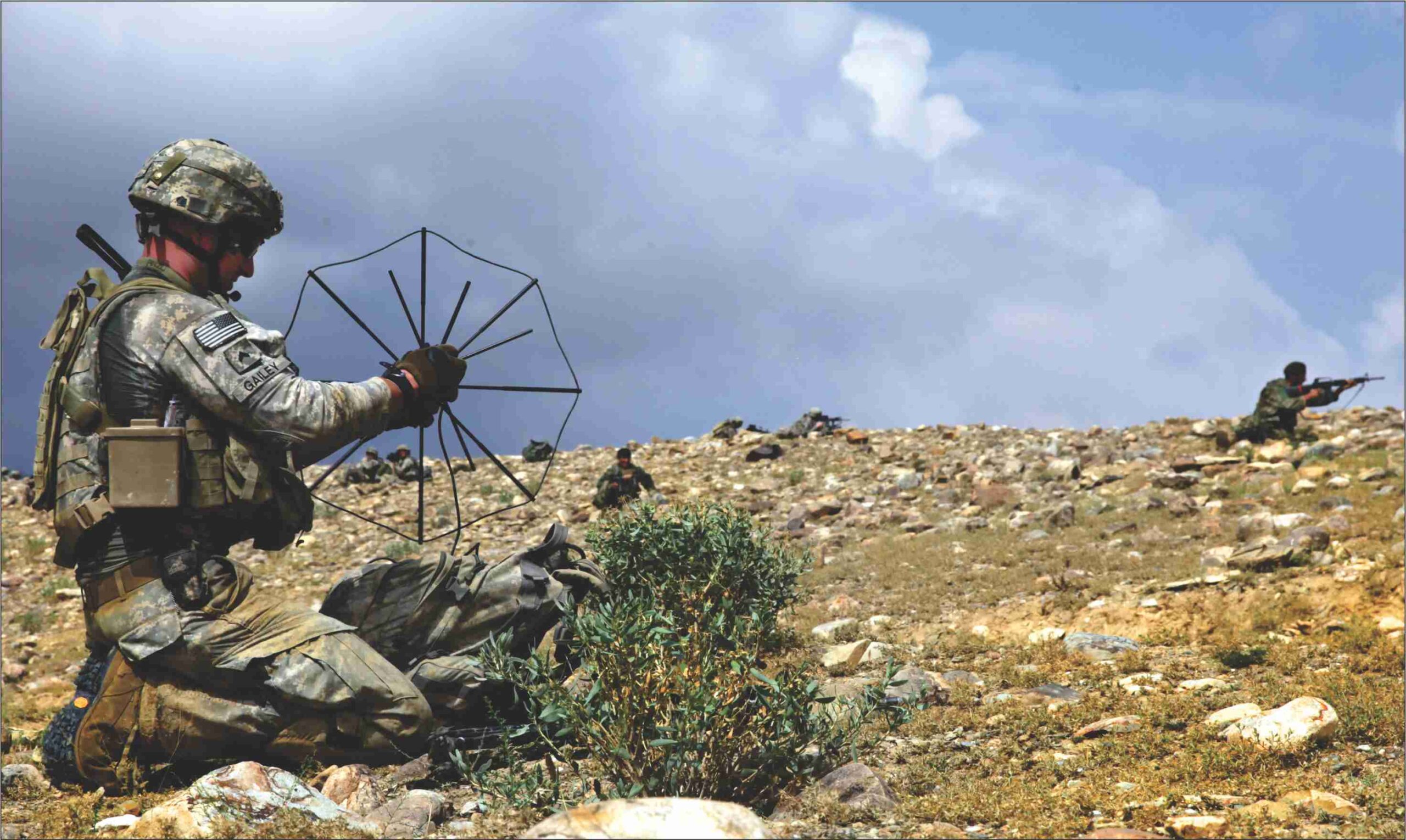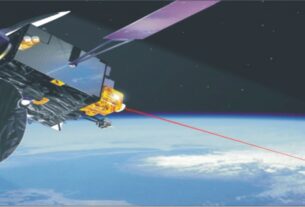The nature of warfare has changed over time. However, certain aspects of battle have remained constant for centuries. Namely, the need to maintain effective command and control of troops, as well as the ability to communicate securely.
Modern day warfare requires military units to operate as smaller, more agile forces, across widely distributed geographic areas, in often rugged terrain.
These dismounted units frequently cannot maintain line-of-sight communications with headquarters (HQ), let alone with other units operating even a few miles away.
This not only limits HQ ability to track dismounted soldiers but also imposes severe limitations on the warfighter’s situational awareness that is vital to both safety and mission success.
The tactical battlefield is now becoming a ground for extensive digital data exchange where many sensors, weapons, computers and command centers need to exchange high speed data in order to perform effectively and coherently.
As the tactical domain is extremely fragile, with rapid mobility in a hostile and dynamic environment, modern day communication tools have reduced the gap between strategic, operational and tactical domains.
On the battlefield, a communications link is a lifeline-a vital connection to comrades & commanders. Whether one is signing on to radio or logging on to a laptop, one needs a network that works – the first time, every time.
Information dominance
To function effectively, military command and control depends on a complex communication network of equipment, personnel, and communication protocols to relay information among forces.
Communications networks are decisive in all aspects of global military responsibilities. Communication has always been important with in the military from day one. Without this communication no soldier would know where to be or when to be there.
Military missions today are often focused on counter insurgency, nation building, and humanitarian aid, requiring warfighters to operate as small forward based units across ever increasing areas of responsibility.
Now more than ever before, commanders must know the location and status of their operational forces and warfighters must be able to call for additional resources, regardless of geographic location. The mission success heavily depends on it.
The dependence on information of all kinds has produced superior combat efficiencies and effectiveness. Today’s military uses significantly smaller and dispersed units to operationally control battlespace areas than in prior warfighting constructs.
The shift to strategic small units is possible, in part, because of the significantly increased lethality of smaller units enabled by the use of ISR capabilities and precision weapons. This precision, however, depends largely on reliable communications. This overall change in operational concepts has become a fundamental shift in military thinking.
Due to highly multi-dimensional and unpredictable battlespace there is a need for quick decision making with a joint command and control structure to direct operations.
Militaries require micro-processing and miniaturisation technologies complementing real-time intelligence and information sharing, distributed decision making, and rapid execution of orders from a wide variety of forces and systems for concentrated effect over the entire spectrum of operations.
Tactical communication systems are of very high operational importance, providing integrated, secure, highly reliable and available communication services for forces, even in constraints like hostile environmental conditions, limited spectrum, time critical and non-linear progress of communication requirements, technical failure of equipment, partial destruction of mesh networks, and jamming by adversaries or events.
Throughout US history, advances in military capability have been fueled by innovation. All branches of the military consistently have managed to use technology in new and creative ways to gain an edge over the enemy.
The ability of US forces to gather, process, and disseminate battlespace information in a networked fashion has given them a tremendous advantage in major combat operations. This battlespace information has allowed US forces to move faster and apply military power more aggressively and effectively.
Today’s networks enable shared situational awareness, unity of action, and enhanced shared understanding. Communication networks needs to be integrated seamlessly and interoperable to be of value despite the challenges of spectrum, bandwidth, low density and laws of physics.
Communication technology
Military communications technologies are vast and complex. Each generation of communications equipment seeks to leverage improvements in component life, such as extended operating time for portable radios running on new rechargeable batteries or increased processing power from the latest high-power microprocessors.
No one technology dominates military communications systems as vital or invaluable. Rather, a large number of technologies are employed to provide security and reliability for military communications systems, and military systems designers are constantly seeking to integrate whatever new technologies may improve military radios and communications systems.
Communications systems for military applications start on the ground and work their way through the atmosphere, with communications systems as traditional as high-frequency (HF) two-way radios to more elaborate satellite-communications systems.
Many companies around the world are busy in developing new communication technologies which are more reliable and securewhileimproving existing equipments for better performance.
Harris RF Communications is the leading global supplier of secure radio communications, tactical communication networks and embedded high-grade encryption solutions for military, public safety, government and commercial customers.
Its tactical communications serves the US Department of Defense, international militaries and government agencies with a comprehensive line of secure radios and systems. Its Falconfamily of software-defined tactical radio systems encompasses manpack, handheld and soldier-worn vehicular applications.
Falcon III is the next generation of radios supporting network-centric operations worldwide. The newest Falcon III radio-the AN/PRC-117G multiband manpack radio-is the only system that is bringing true wideband networking capabilities to the battlefield today.
These systems, along with the Falcon III handheld and vehicular radios, give militaries unprecedented situational awareness capabilities, including streaming video to the tactical edge of the battlefield.
Internationally, Harris Falcon radios form the foundation for high-performance system solutions that address comprehensive requirements in command and control, homeland security, disaster relief, narcotics interdiction and other applications.
For instance, the new RF-7800S Secure Personal Radio acts as the hub in Falcon Fighter, a newly introduced soldier system.
Harris tactical radios are changing the way warfigters conduct their missions, and are saving military and non-combatant lives on the borderless battlefield.
From secure, high-frequency radios to sophisticated software-defined radio technologies, Rockwell Collins solutions span the entire operational spectrum and integrate seamlessly with existing military platforms. Its products and systems that keep pilots and soldiers connected-no matter the domain.
The company at Defcom 2012, India presented some of its best communication equipment such as FlexNet, a software defined radio developed by Rockwell Collins and Thales, two Mobile Ad Hoc Networking (MANET) systems. The company also presented airborne radios.
Rockwell Collins has experience in fielding both types of MANET solutions, the subnet relay capability which is being deployed as the NATO standard Mobile Ad Hoc Relay Line-of-Sight IP Networking (MARLIN), along with the FlexNet Waveform, which is designed as a core capability of the FlexNet radios.
The later are already operational with the US Army and the company is offering it to the Indian Army which is committed to upgrading their software defined radios (SDR).
The Rockwell Collins NextGeneration Talon software defined radio (SDR) is the latest fullyexportable Receiver-Transmitter (RT) stemming from its provenARC-210 advanced communication system family.
The Next Generation Talon deliversmission critical capability, relying on its proven performancerequired by advanced warfighters calling for mobile ad hocnetworked communications or point-to-point data, voiceand imagery.
Rockwell Collins delivers smart communication and aviationelectronic solutions to customers worldwide.
Situational awareness
Exelisis a globally recognized technology leader specializing in tactical communications systems, mobile satellite communications systems, global positioning systems (GPS), mobile ad hoc networking (MANET) solutions, and integrated command, control and communications (C3) solutions.
Its systems include the Single Channel Ground and Airborne Radio System (SINCGARS), the Advanced Tactical Communications System (ATCS), as well as the Soldier Radio Waveform (SRW)-the US next generation tactical networking waveform capability to support Network Centric Operations among virtually all Joint Tactical Radio System programs and radio form factors. Other solutions include SpearNet, Spearhead and Soldier Radio handheld communication systems; SideHat SRW appliqué and the High Capacity Data Radio.
The company is a recognized technology leader in secure, robust, jam resistant communications with low probability of detection and low probability of intercept capabilities and in mobile, ad hoc (MANET) networking, waveforms and associated technologies. Emerging products and systems include the Global Network on the Move-Active Distribution (GNOMAD) wideband, secure, mobile satellite communications system.
Its Distributed Tactical Communication System (DTCS) provides Beyond Line-Of-Sight (BLOS), Over-The-Horizon (OTH), and On-The-Move (OTM) one-to-many tactical voice and data communications.
DTCS is managed by the Defense Information Systems Agency (DISA) through its Enhanced Mobile Satellite Services (EMSS) program management office.As a proud partner in the development of DTCS, Exelis has played an instrumental role in the engineering, design, implementation, and deployment of this Iridium satellite based system.
To address the urgent needs of US troops in Iraq and Afghanistan, Exelis designed and developed the only generally available DTCS compatible radio in the world.
Already, thousands of its handheld RO Tactical Radios are in the field, enabling reliable command and control capability, regardless of location or terrain. All that is required is a view of any part of the sky and the RO Tactical radio can engage DTCS.
Lockheed Martin understands the communications needs of the net-centric warfighter. Reliability is perhaps the most important feature of any communications systems.
Interoperability is a major challenge for net-centric communications. The company focuses on flexible, open architectures that connect airborne, naval and ground-based networks.
These networks embrace new hardware and software – if a new hand-held computer is introduced, the network adapts to connect with the new device, just as it will for antennas, routers and satellites.
To accurately respond to threats, users need access to intelligence from a variety of sources, with varying levels of classification.
Secure intelligence
Lockheed’s technologies expand the capabilities of secure intelligence sharing. At every layer of the network, the latest security and information assurance technologies keep data safe and trusted-
while allowing access to authorized users.
Its new systems like the Army’s Warfighter Information Network-Tactical (WIN-T) will use a layered, managed network architecture to deliver connectivity as trusted as a dial tone.
If the line-of-sight connection is obstructed, WIN-T will automatically switch to airborne nodes. If those systems are unavailable, the network will instantly switch to a satellite link. Because the network is self-managed, the warfighter does not need to worry about which node he is currently working, the system does all the work for him.
Even its Mobile User Objective System(MUOS) is an ultra high frequency (UHF)satellite communications (SATCOM)program.MUOS will provide the mobile warfighter with point-to-point and netted communications services with a secure “comm on the move” capability on a 24×7 basis.
ASELSAN is a Turkish Armed Forces Foundation company which is offering its Tactical Area Communications System (TASMUS) to the world militaries.
ASMUS is a tactical area communications system which provides network centric communication infrastructure. The main goal of TASMUS is to provide a common picture of the battlefield in near-real time and shares data among battlefield systems.
It facilitates fusion and display of intelligence information to commanders at all levels and handles the exchange of targeting data from sensor to weapon systems.
TASMUS aims to form mobile, survivable, flexible and secure network to support all the present and future communication requirements of the commanders in the tactical field.
TASMUS brings together state-of-the-art military communication technologies while enabling access through wired user terminals, mobile radios, integrated Combat Net Radio networks and Tactical Wireless Local Area Network (LAN) in the tactical field.
TASMUS is deployed in the area of military operations such that, seamless communication between the army and battalion/company level is achieved.
It provides interfaces to the strategic telecom and data networks, while providing connection to the existing Combat Net Radio systems via Combat Net Radio Interface.
Military communications technology must be developed for efficient use of available bandwidth as well as effective interoperability of equipment among the armed forces. Indian companies like BEL, HCL, Tata Power SED and L&T are also investing heavily in developing advanced communication systems for Indian armed forces.
BEL has already gained expertise in developing military warfare communications. Rolta provides secure triple-play services for voice, data and video communication for forces spread over vast regions in a Tactical Battlefield Area.
To ensure secure information transfer in far-flung locations, Rolta offers an array of Tactical Radios, which enable Defence forces to interoperate with legacy radios and provide communications while being on the move.
Rolta’s IP Radio supports a variety of configurations including point to-point (PtP), point-to-multipoint (PtMP) and mobile ad-hoc networks (MANET).Rolta offers a Multiband Software Defined Radio solution for tactical mobile communications, providing secure voice and data services.
Satellite
Although significant investments are still made in the development of effective terrestrial radios, a growing number of systems are incorporating satellites as part of their communications links.
The military is embracing the communications revolution, turning to a new generation of sophisticated systems to enable faster, richer, less costly and more flexible communications.
Recent years have seen a phenomenal growth in the field of satellite communications. Satcom systems offer many advantages for military applications which include wide area coverage, rapid deployment, flexible networking and long range service to moving platforms like ships, aircraft and vehicles.
Military satellite communications have become essential to help the warfighter with assured global connectivity, even in remote areas with no communications infrastructure. Mobile and tactical military satellite communication systems are characterized by terminals with small antennas on ships, submarines, boats, land vehicles, and aircraft.
They also service large transportable terminals, lightweight backpack terminals, and even handheld terminals or terminals located on cruise missiles.
They primarily convey voice and data (with growing applications to include telemetry, imagery, texting, file transfer, remote sensor computer access, paging, email and Internet, and facsimile) and extend to video teleconferencing and video.
The needs of tactical military communications have given rise to the development of small road and air transportable terminals which can be quickly shifted to a new location and deployed within a short time under field conditions to provide secure and reliable communication between the moving units.
While early satellite communications systems had a life span of days or weeks, today’s systems have design lives extending to 14 years and beyond, with a typical mean mission duration of 10 years. This is necessary to justify system effort and cost of development and operations. Over the years, increasing demand for capacity has required improved satellite designs.
In order to meet the demands of command and control of highly mobile units/moving platforms such as the ships and aircrafts with modest bandwidth requirements, satellite systems built around lower frequencies (UHF) evolved to fill the critical need of tactical communications.
The desire to improve Satcom service to both the strategic and tactical users has led to the use of higher frequency bands. With the growing operational deployment of Satcom systems several new requirements are influencing the future developments to realize more robust and flexible systems for military applications.
Communications is vital to the modern military establishment. Satellites permit direct communications with units on the battlefield. Light-weight mobile terminals can be erected in a matter of hours, keeping advancing troops in constant contact with higher authorities.
However, satellite communication faces enemy threats and is quite vulnerable method of communication. Satellite communications have an intrinsic vulnerability to jamming and unauthorized interception. Jamming of satellite transponders can be a serious threat.
The threats to Satcom systems can be physical attacks on satellite constellations, like ASAT test, or directed energy attacks, such as high-powered lasers and microwave systems that can degrade or damage critical satellite components like solar arrays and sensors.
Another type of physical attack might not be directed at the satellites, but at their ground stations causing similar disruption in communications in a less expensive manner.
Further the electronic attacks can jam the capabilities to uplink or downlink data and commands between ground stations and satellites. Cutting off communications through jamming or the destruction of infrastructure could be devastating to battlefield commanders.
Even the threat of cyber attack is a matter of serious concern as it can be more damaging than any other jamming or similar tactics.
Cyberspace is one domain that needs to defended, just like the air, land, and sea.An adversary gaining control of satellite systems, uplink jamming, and assaults on ground stations are the major challenges faced by the satellite communication systems.
Heavy reliance on computers by militaries for communications, vehicle control, surveillance, and signal processing makes it imperative for armed forces to keep data secure from nations and groups hostile to national interests.
Accurate intelligence about the enemy is always something any military looks forward to, and success in future conflicts will require technologies that can perform persistent surveillance to help identify enemies and friendly forces.
Reliable secure communication is a key to success in today’s advanced networking battlespace.





